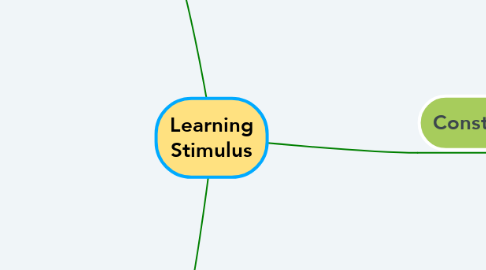
1. Behaviourism
1.1. Observable Response
1.2. Contributors
1.2.1. Watson
1.2.1.1. "Little Albert" experiment
1.2.1.1.1. classical conditioning e.g. sharp noise
1.2.1.2. Kerplunk experiment
1.2.1.2.1. kinesthetic learning e.g running maze
1.2.2. Skinner
1.2.2.1. Operant Conditioning
1.2.2.1.1. reinforcers e.g. food pellet
1.2.2.1.2. punishers e.g. shock
1.3. Teacher centered
1.3.1. Knowledge
1.3.1.1. teacher provides external stimuli from which students learn
1.4. Classroom
1.4.1. Contracts
1.4.1.1. helps focus on behaviour change
1.4.2. Consequences
1.4.2.1. Reinforcement
1.4.2.1.1. Positive
1.4.2.1.2. Negative
1.4.2.2. Punishment
1.4.2.2.1. Positive
1.4.2.2.2. Negative
1.4.3. Extinction
1.4.3.1. take away stimulus
1.4.4. Modelling
1.4.4.1. Shaping
1.4.4.1.1. breaking down desired behaviour into units e.g. class enters room, then class sits, then class takes out books, then class quiet
1.4.4.2. Cueing
1.4.4.2.1. cue to illicit desired behaviour e.g. clapping sequence to get attention
1.5. Pros and Cons
1.5.1. Pros
1.5.1.1. easily quantifiable
1.5.1.2. easily implemented
1.5.2. Cons
1.5.2.1. one-dimensional i.e. only focuses on observable actions
1.5.2.2. really only works on the individual
2. Cognitivism
2.1. Process
2.1.1. Storage
2.1.1.1. Response
2.2. Contributors
2.2.1. Bandura
2.2.1.1. Modelling
2.2.1.1.1. Bobo Doll
2.2.1.1.2. Mass Media
2.3. Classroom
2.3.1. Student centered
2.3.1.1. expectancy component
2.3.1.1.1. Can I do the task?
2.3.1.2. value component
2.3.1.2.1. Why am I doing this task
2.3.1.3. affective component
2.3.1.3.1. How do I feel about this task?
2.3.1.4. Knowledge
2.3.1.4.1. learned from others
2.3.2. Modelling
2.3.2.1. demonstrations, illustrative examples, constructive feedback
2.3.3. Scaffolding
2.3.3.1. moving info from STM to LTM
2.3.3.1.1. link new material to old
2.3.4. Chunking
2.3.4.1. limit amount of new content
2.3.4.1.1. less is more
2.3.5. Promote self regulation
2.3.5.1. metacognitive reflection, feedback, variety of instructional tools
2.3.5.1.1. words and graphics
2.4. Pros and Cons
2.4.1. Pros
2.4.1.1. bridges behaviourism and constructivism
2.4.1.2. explains how conceptual change occurs
2.4.1.3. easier to implement in classroom than constructivism
2.4.2. Cons
2.4.2.1. based on controlled experiments i.e. focused on one stimulus
2.4.2.2. doesn't take whole student into account
2.4.2.3. focuses on traits that may not be observable in all people
3. Constructivism
3.1. Rules/mental models
3.1.1. Rules/mental models
3.1.1.1. New learning stimulus
3.2. Contributers
3.2.1. Piaget
3.2.1.1. Cognitive Constructivism
3.2.1.1.1. Four Stages
3.2.1.1.2. Schema
3.2.2. Vygotsky
3.2.2.1. ZPD
3.2.2.1.1. Scaffolding
3.2.2.2. Sociocultural Constructivism
3.2.2.2.1. social interaction
3.2.3. Others
3.2.3.1. Glasersfeld
3.2.3.1.1. "foster the art of learning"
3.2.3.2. Dewey
3.2.3.2.1. blended curriculum, PBL, IEP
3.2.3.3. Bruner
3.2.3.3.1. students ask questions in quest
3.2.3.3.2. information presented based on three stages
3.3. Classroom
3.3.1. Student Centred with Teacher as Guide on the Side
3.3.1.1. Knowledge
3.3.1.1.1. individually unique
3.3.1.1.2. based on experience
3.3.1.1.3. built by learner
3.3.1.2. asking questions
3.3.1.3. active learner
3.3.1.3.1. exploration
3.3.1.4. engaged
3.3.1.4.1. mediate and controls learning
3.3.1.5. working in groups
3.3.1.5.1. alternate viewpoints
3.3.1.6. teacher is resource/tool
3.3.1.6.1. misinterpretations
3.3.1.6.2. guide on side
3.3.1.7. chunking
3.4. Pros and Cons
3.4.1. Pros
3.4.1.1. Promotes Collaboration
3.4.1.1.1. play games
3.4.1.1.2. collaborative work
3.4.1.2. Activates Higher Level Thinking
3.4.1.2.1. role playing
3.4.1.2.2. Inquiry based learning
3.4.1.2.3. interactive examples
3.4.1.3. Based on Prior Learning
3.4.1.3.1. PBL
3.4.1.3.2. experiments and simulations
3.4.1.4. Student-Centered
3.4.1.4.1. reciprocal teaching
3.4.2. Cons
3.4.2.1. Significant Amount of Time
3.4.2.2. Depth not Breadth
3.4.2.3. Lack of Structure
3.4.2.4. Lack of Training from Teachers
